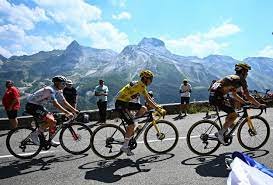Tour de France
The Tour de France, often referred to as the “Grand Boucle,” is one of the most iconic and challenging cycling races in the world. With its storied history, grueling mountain stages, and exhilarating sprints, the Tour de France has captivated cycling enthusiasts and sports fans for over a century. In this blog, we’ll take an exhilarating ride through the history, stages, and significance of this legendary race.
A Legacy of Cycling Excellence
The Tour de France was first organized in 1903 by the French newspaper L’Auto as a means to boost its circulation. Little did they know that this race would evolve into one of the most prestigious events in the sports world. The race’s enduring popularity can be attributed to its blend of athleticism, strategy, and the sheer determination of the cyclists.
The Stages and Challenges
The Tour de France is not just a race; it’s a journey that traverses various terrains, testing every aspect of a cyclist’s abilities:
1. Flat Stages: These stages feature high-speed sprints where sprinters compete for the coveted green jersey, awarded to the best sprinter.
2. Mountain Stages: The mountain stages are perhaps the most famous, as cyclists battle through grueling ascents and adrenaline-pumping descents in the pursuit of the polka dot jersey for the King of the Mountains.
3. Time Trials: Individual and team time trials challenge cyclists to race against the clock, showcasing their raw power and against-the-clock precision.
Yellow Jersey and Strategy
The iconic yellow jersey, worn by the overall race leader, symbolizes the spirit of the Tour de France. The race strategy involves a delicate balance between protecting the yellow jersey, chasing stage victories, and accumulating points for various jersey classifications.
The Human Drama
Beyond the physical demands, the Tour de France is a stage for human drama and perseverance:
1. Team Dynamics: Cycling is not just an individual sport in the Tour. Team dynamics, teamwork, and strategy play pivotal roles in a rider’s success.
2. Camaraderie and Rivalries: The camaraderie among cyclists is juxtaposed with intense rivalries, creating a dynamic and captivating narrative.
Cultural Significance
The Tour de France is more than a sporting event; it’s a cultural phenomenon that unites people across the globe:
1. National Pride: Riders from different countries participate, evoking national pride and uniting fans from various corners of the world.
2. Scenic Splendor: The race showcases the stunning landscapes and iconic landmarks of France, giving viewers a visual feast.
3. Inspiration: The sheer determination of cyclists to overcome challenges serves as an inspiration to athletes and enthusiasts alike.
Conclusion
The Tour de France stands as a testament to the indomitable human spirit, pushing cyclists to their limits and showcasing the beauty of strategy, teamwork, and individual excellence. This epic race continues to capture the hearts and minds of people worldwide, proving that the pursuit of greatness transcends physical boundaries. As the cyclists pedal through picturesque landscapes and historical landmarks, they also journey through history, transforming each Tour into a chapter of the rich narrative of cycling’s greatest race.



